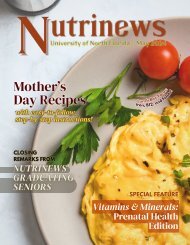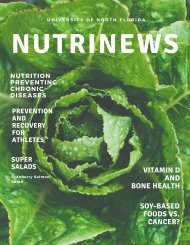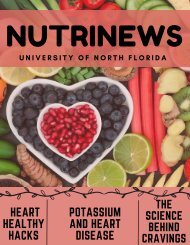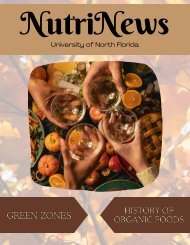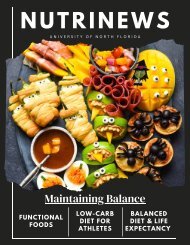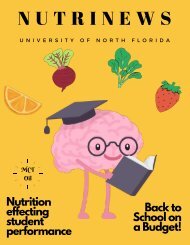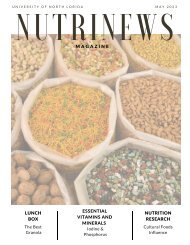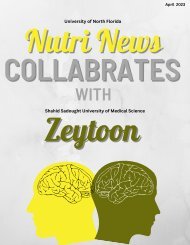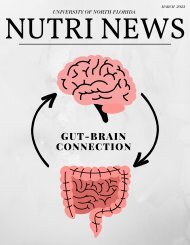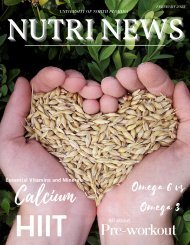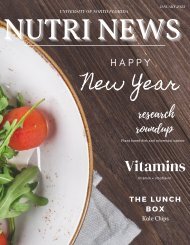Nutri News November 2022
In this month issues you will find articles about: • The research on how biotechnology can improve food production and the nutrition content of foods • How can meal planning help you, especially when consuming a vegan diet. • Delicious vegan recipes in the lunch box! • The truth behind plant-based meat substitute, are they really healthier? • Do plants have protein? yes or no? check our myth busting article to find out the answer. • New findings on the effects of fasting diets on Alzheimer’s disease. • Effects of whole foods plant-based diet on health, especially brain health. • What is the difference in diet between sport related fitness and health related fitness. • Differences between incomplete and complete proteins, and before you ask, yes!! there is a difference. This month’s student spotlight is Maria Rachel Tipton, check what she has to say in page 12! For this month interview, register dietitian Pamela Malo speaks on “the core nutrients that will lead to career fulfillment”, book recommendation to help students cultivate their mindset, what is peaceful eating and much more! If you are looking to make an impact on campus as well as in the community, look for the fliers highlighting volunteer opportunities. These amazing programs are always looking for more volunteers. It is amazing the difference we can make when we all work together for a better and healthier tomorrow. Happy reading!
In this month issues you will find articles about:
• The research on how biotechnology can improve food production and the nutrition content of
foods
• How can meal planning help you, especially when consuming a vegan diet.
• Delicious vegan recipes in the lunch box!
• The truth behind plant-based meat substitute, are they really healthier?
• Do plants have protein? yes or no? check our myth busting article to find out the answer.
• New findings on the effects of fasting diets on Alzheimer’s disease.
• Effects of whole foods plant-based diet on health, especially brain health.
• What is the difference in diet between sport related fitness and health related fitness.
• Differences between incomplete and complete proteins, and before you ask, yes!! there is a difference.
This month’s student spotlight is Maria Rachel Tipton, check what she has to say in page 12!
For this month interview, register dietitian Pamela Malo speaks on “the core nutrients that will lead to career fulfillment”, book recommendation to help students cultivate their mindset, what is peaceful eating and much more!
If you are looking to make an impact on campus as well as in the community, look for the fliers highlighting volunteer opportunities. These amazing programs are always looking for more volunteers. It is amazing the difference we can make when we all work together for a better and healthier tomorrow.
Happy reading!
You also want an ePaper? Increase the reach of your titles
YUMPU automatically turns print PDFs into web optimized ePapers that Google loves.
University of North Florida <strong>2022</strong><br />
NUTRI NEWS<br />
N O M E A T N O V E M B E R<br />
FOOD<br />
SCIENCE<br />
The truth about Plantbased<br />
Meat Substitutes<br />
NUTRITION<br />
RESEARCH<br />
Plant-based food and its<br />
effect on you<br />
SPORTS<br />
NUTRITION<br />
Diet Differences between Sports<br />
related Fitness and Health related<br />
fitness
04.<br />
TABLE OF<br />
CONTENT<br />
YOUR ESSENTIAL GUIDE TO VITAMINS<br />
AND MINERALS<br />
Vitamin E<br />
INTERNATIONAL COLLABORATION<br />
06. CRISPR/CAS9<br />
09.<br />
MONTHLY HACKS- PART 1<br />
Why meal planning is important when<br />
consuming a vegan diet<br />
"Prevention<br />
is better<br />
than a<br />
cure"<br />
STUDENT SPOTLIGHT<br />
12. Mary Tipton<br />
15.<br />
17.<br />
19.<br />
22.<br />
25.<br />
29.<br />
32.<br />
MYTHBUSTING<br />
Do plants have protein?<br />
THE LUNCH BOX<br />
Popcorn Tufu Tacos<br />
RESEARCH ROUND UP<br />
Fasting-Mimicking Diet and Alzheimers<br />
FOOD SCIENCE<br />
The Truth about Plant Based Meat<br />
Substitutes<br />
MYSTERY INTERVIEW<br />
Pamela Malo<br />
NUTRITION RESEARCH<br />
Whole Foods Plant based and it's effect on you<br />
SPORTS NUTRITION<br />
The Diet Difference between Sports Related<br />
Fitness and Health Related Fitness<br />
MONTHLY HACKS- PART 2<br />
34. Complete Protein vs Incomplete Protein<br />
36.<br />
NUTRINEWS STAFF<br />
Follow us!<br />
@unfnutrinews
Your Essential Guide to Vitamins<br />
& Minerals<br />
This month is vitamin E!<br />
Written By: Ashley Valle & Sophie Van Moorleghem<br />
We are frequently told to enjoy a rainbow<br />
of fruits and vegetables to attain all our<br />
vitamins and minerals. Yet, we hardly<br />
learn about these vitamins and minerals<br />
past the simple ones like vitamin C and<br />
calcium. However, it is important to make<br />
sure that we understand all our vitamins<br />
and minerals so that we can adequately<br />
judge what we need and what we don't.<br />
This series of articles aims to do just that,<br />
with this month being vitamin E!<br />
Discovered in 1922 by Evans and Bishop,<br />
vitamin E is found as alpha tocopherol in<br />
the body.1,2 Vitamin E is a fat-soluble<br />
vitamin responsible for aiding in the<br />
health of your brain, skin, and blood. It<br />
can also influence your vison and<br />
reproductive system because of its<br />
antioxidant properties. An antioxidant is a<br />
popular, protective substance that helps<br />
your cells against free radicals<br />
(destructive molecules from tobacco,<br />
4
adiation, etc.). With its protective<br />
properties, it can help to fight chronic<br />
diseases, such as cancer, heart disease,<br />
fatty liver disease, and Alzheimer’s.3<br />
Furthermore, due to its effect on the body’s<br />
blood supply, studies have shown that<br />
taking vitamin E before and after<br />
menstruation can help decrease cramps,<br />
pain, and overall blood loss during this<br />
time. Additionally, taking this vitamin has<br />
also been shown to reduce swelling or<br />
inflammation associated with fat buildup in<br />
the liver, particularly in people with<br />
nonalcoholic liver disease. These are just a<br />
few of the conditions that vitamin E can<br />
help with, and that's why it's important to<br />
have it in your healthy diet.4<br />
Vitamin E is found in plant oils, such as<br />
olive oil and safflower oil, nuts, seeds, such<br />
as almonds and peanuts, and fruits and<br />
vegetables, such as avocado, mango,<br />
asparagus, and spinach. It can also be<br />
found in fortified foods like juices and<br />
cereals.2,3 The daily recommended amount<br />
of vitamin E depends on age. Adults and<br />
pregnant people should aim for 15mcg<br />
daily, and breastfeeding people should aim<br />
for 19mcg.2<br />
Typical symptoms of vitamin E deficiency<br />
are weakened immune system, damage to<br />
nerves and muscles, and damage to the<br />
retinas.4 Some examples of diseases that<br />
could inhibit vitamin E absorption would<br />
be Crohn’s disease and cystic fibrosis.2<br />
Vitamin E is an important nutrient that is<br />
best acquired naturally. So, whenever<br />
possible, it is important to reduce your<br />
supplementation of this product and<br />
choose a dietary option. With its<br />
antioxidant properties, it is clear to see<br />
how vitamin E is an essential vitamin and<br />
a normal part of a healthy diet. However,<br />
because of the rise of supplements, it can<br />
be easy to opt for supplementation, even<br />
when it is not a necessity. In almost all<br />
cases, the key to getting all our vitamins<br />
and minerals is through food-based<br />
choices with nutritionally satisfying<br />
meals.<br />
Although vitamin E deficiency is rare, it is<br />
possible and often found in people with<br />
diseases that negatively affect fat digestion<br />
and absorption.2 Since vitamin E is a fatsoluble<br />
vitamin, fat must be present in the<br />
diet for it to be used by the body.<br />
References:<br />
1. Bell EF. History of vitamin E in infant nutrition. Am J Clin Nutr. 1987;46(1 Suppl):183-186. doi:10.1093/ajcn/46.1.183<br />
2. Vitamin E. Nih.gov. Accessed September 25, <strong>2022</strong>. https://ods.od.nih.gov/factsheets/VitaminE-Consumer<br />
3. Vitamin E. Mayo Clinic. Published <strong>November</strong> 13, 2020. Accessed September 25, <strong>2022</strong>. https://www.mayoclinic.org/drugs-supplements-vitamin-e/art-20364144<br />
4. VITAMIN E: Overview, Uses, Side Effects, Precautions, Interactions, Dosing and Reviews. Webmd.com. Published 2012. Accessed September 25, <strong>2022</strong>.<br />
https://www.webmd.com/vitamins/ai/ingredientmono-954/vitamin-e<br />
<br />
5
INTERNATIONAL COLLABRATION<br />
Doctorado en Ciencias de la <strong>Nutri</strong>ción Traslacional, Centro Universitario de Ciencias de la Salud (CUCS),<br />
Universidad de Guadalajara (UdeG), Guadalajara 44320, Mexico<br />
By Nava-Amante Pablo<br />
Alejandro, Betancourt-Núñez<br />
Alejandra & Vizmanos Barbara<br />
<br />
Introduction<br />
During agriculture and post-harvest activities, a lot of food is lost. Losses of plantderived<br />
foods are around 16% (U.S.) and 20% (Latin America) (1). The world’s<br />
population continues to increase, therefore, securing food for present and future<br />
generations with minimal lost is necessary. In this sense, food waste, in the not-toodistant<br />
future, will be a global problem. To solve this preoccupation, some<br />
researchers have worked on developing tools to improve food production and<br />
nutrient contents. One of these tools focused on is CRISPR (the acronym for<br />
Clustered Regularly Interspaced Short Palindromic Repeats) and its complement<br />
Cas9 (an enzyme associated).<br />
CRISPR/Cas9 was adapted to avoid naturally but undesired functions that make<br />
plants susceptible/sensitive to stress. This stress can be abiotic (i.e., cold or hot) or<br />
biotic (i.e., insects, infections). Whatever type it is, it could affect the yield and quality<br />
of crops. Unwanted functions decrease overall food production (2). However, a<br />
contrasting position has been established by some persons who present<br />
preoccupation with health implications when crops' genes (information) are edited.<br />
Therefore, the present essay aims to briefly expose CRISPR/Cas9 and its present and<br />
future prospects for food production and nutrient contents, including the regulatory<br />
framework of plant changes.<br />
6
How CRISPR/Cas9 works?<br />
CRISPR is DNA sequences (information) that bacteria have and use to protect<br />
themselves from virus attacks. In addition, the protection is completed with another<br />
tool associated with CRISPR: Cas9. Cas9 works as "scissors" bacteria use to cut<br />
components (DNA) from viruses. As part of its genetic material, these components<br />
are saved by bacteria to know how to respond to future attacks (3). In other words,<br />
CRISPR/Cas9 is bacteria's defense system (immune system) that protects them from<br />
viruses. If bacteria survive viruses' infection, they take (cutting DNA parts from virus)<br />
the information necessary to fight future viruses' attacks (3). This interesting<br />
CRISPR/Cas9 was observed for the first time in 2012. It has been applied to crops to<br />
make them stronger from attacks of infections or climate, which usually decrease<br />
overall food production (2).<br />
What does science say about using CRISPR/Cas9 in food?<br />
The utilization of CRISPR/Cas9 can increase food quantity and quality. The food<br />
Doctorado en Ciencias de la <strong>Nutri</strong>ción Traslacional, Centro Universitario de Ciencias<br />
groups<br />
de<br />
in<br />
la<br />
which<br />
Salud (CUCS),<br />
the CRISPR/Cas9<br />
Universidad de<br />
system<br />
Guadalajara<br />
has<br />
(UdeG),<br />
been<br />
Guadalajara<br />
applied are<br />
44320,<br />
mainly<br />
Mexico<br />
grains (i.e.,<br />
rice, maize, barley, wheat) or tomatoes. The primary outcomes have been increasing<br />
the size, number, and productivity of grains or fruits (2).<br />
The nutrient content improvement from food groups has been poorly studied (2).<br />
For example, in rice, CRISPR/Cas9 application help to increase β-carotene (a form of<br />
vitamin A) (4) and oleic acid content (a healthy fat) (5), as well as decreasing phytic<br />
acid accumulation (called antinutrient because it reduced the absorption of iron,<br />
zinc and, calcium in humans’ digestion) (6).<br />
CRISPR/Cas9 is a clear example of translational research that begins at the basic<br />
science level (i.e., in laboratories where genes are studied) and is subsequently<br />
applied to solving problems, such as improving food production. This could help to<br />
end the concern of future food insecurity/availability (7).<br />
7
Regulatory framework for CRISPR/Cas9<br />
Although CRISPR/Cas9 applications has many advantages, there are some ethical<br />
considerations. Some people are against genetically modified foods. There is concern<br />
around the possibility of adverse health effects of consuming transgenic foods (foods<br />
whose original DNA was changed/replaced with genes from other plants). However,<br />
no adverse health effects have been reported from the consumption of transgenic<br />
food (8).<br />
Some foods modified by CRISPR/Cas9 are not strictly transgenics (because no<br />
information from other organisms is used), but some are. Therefore, CRISPR/Cas9<br />
utilization regulations in crops are divided into the process (considered transgenic)<br />
and end-product (not always regarded as transgenic). 1) Process for obtaining the<br />
crop regulation is implemented in Europe, India, New Zealand, and Australia. 2) The<br />
end-product regulation is implemented in U.S., Argentina, and Canada. The endproduct<br />
regulatory assessment can remove the transgene used in the CRISPR/Cas9<br />
process. In this sense, the transgenic regulations will not be applied, reducing cost<br />
and regulatory burden, and bringing benefits to consumers (2). Therefore, the<br />
improvement of food production cannot be delayed.<br />
Conclusion<br />
CRISPR/Cas9 could help improve food production and nutrient contents to ensure<br />
food for present and future generations. However, further research is needed to<br />
ensure that food edited with CRISPR/Cas9 is safe. In addition, we, as consumers,<br />
must begin to act. A large amount of food is wasted at the consumer level, around<br />
121 kg per capita! This leads to environmental, social, and economic problems (9).<br />
8<br />
References<br />
<br />
1. FAO. Global food losses and food waste - Extent, causes and prevention [Internet]. Food Loss and Food Waste: Causes and Solutions.<br />
Rome: Edward Elgar Publishing Ltd.; 2011. 37 p. Available from: https://www.fao.org/sustainable-food-valuechains/library/detalles/es/c/266053/<br />
2. Ahmad S, Tang L, Shahzad R, Mawia AM, Rao GS, Jamil S, et al. CRISPR-Based Crop Improvements: A Way Forward to Achieve Zero<br />
Hunger. J Agric Food Chem. 2021;69(30):8307–23.<br />
3. Bayer. ¿Qué es la tecnología CRISPR? [Internet]. 2021 [cited <strong>2022</strong> Apr 10]. Available from: https://www.bayer.com/es/es/blog/espanaque-es-la-tecnologia-crispr<br />
4. Dong OX, Yu S, Jain R, Zhang N, Duong PQ, Butler C, et al. Marker-free carotenoid-enriched rice generated through targeted gene<br />
insertion using CRISPR-Cas9. Nat Commun. 2020 Mar;11(1):1178.<br />
5. Abe K, Araki E, Suzuki Y, Toki S, Saika H. Production of high oleic/low linoleic rice by genome editing. Plant Physiol Biochem PPB.<br />
2018 Oct;131:58–62.<br />
6. Khan MSS, Basnet R, Islam SA, Shu Q. Mutational Analysis of OsPLDα1 Reveals Its Involvement in Phytic Acid Biosynthesis in Rice<br />
Grains. J Agric Food Chem. 2019 Oct;67(41):11436–43.<br />
7. FAO. Declaración de Roma sobre la Seguridad Alimentaria Mundial [Internet]. Cumbre Mundial de la Alimentación. Roma, Italia; 1996.<br />
Available from: http://www.fao.org/3/w3613s/w3613s00.htm<br />
8. National Library of Medicine. Genetically engineered foods [Internet]. MedlinePlus Trusted Health Information for You. <strong>2022</strong>. Available<br />
from: https://medlineplus.gov/ency/article/002432.htm<br />
9. United Nations. UN: 17% of all food available at consumer levels is wasted [Internet]. UN environment programme. 2021 [cited <strong>2022</strong><br />
Sep 30]. Available from: https://www.unep.org/news-and-stories/press-release/un-17-all-food-available-consumer-levels-wasted
Why meal planning is<br />
important when<br />
consuming a vegan diet<br />
B y G e o r g i n a B r a c e<br />
V e g a n d i e t s a r e b a s e d o n p l a n t s a n d f o o d s<br />
m a d e f r o m p l a n t s . T h i s d i e t i s k n o w n t o h a v e<br />
m a n y d i f f e r e n t h e a l t h b e n e f i t s , h o w e v e r<br />
t h e r e a r e a f e w k e y n u t r i e n t s t h a t v e g a n s m a y<br />
n e e d t o s u p p l e m e n t i n o r d e r t o a v o i d a n y<br />
d e f i c i e n c i e s . V e g a n d i e t s a r e r i c h i n f r u i t s<br />
a n d v e g e t a b l e s a n d u s u a l l y l o w i n r e f i n e d<br />
f o o d s , h o w e v e r a n y d i e t t h a t l a c k s f o o d<br />
g r o u p s m a y r e s u l t i n l a c k o f n u t r i e n t s . V e g a n<br />
d i e t s c a n b e v e r y n u t r i t i o u s a n d d e l i c i o u s a s<br />
l o n g a s t h e y a r e p l a n n e d w e l l . S o m e<br />
n u t r i e n t s t h a t t h e v e g a n d i e t m a y l a c k a r e<br />
V i t a m i n B 1 2 , O m e g a - 3 ’ s , I o d i n e , I r o n , V i t a m i n<br />
D 3 , a n d C a l c i u m . H o w e v e r , m o s t o f t h e s e<br />
n u t r i e n t s c a n b e s u p p l e m e n t e d t h r o u g h<br />
s p e c i f i c f o o d s o r o t h e r s u p p l e m e n t a t i o n s .<br />
V i t a m i n B 1 2 i s s e e n i n m a n y t y p e s o f a n i m a l<br />
p r o d u c t s w h i c h i s w h y v e g a n s a r e o f t e n<br />
d e f i c i e n t i n t h i s n u t r i e n t , h o w e v e r m a n y<br />
v e g a n s t a k e B 1 2 s u p p l e m e n t s t o h e l p e n s u r e<br />
s u f f i c i e n t i n t a k e . O m e g a - 3 ’ s a r e a l s o a l a r g e<br />
p a r t o f t h e d i e t a n d c o n t r i b u t e t o h e a r t a n d<br />
b r a i n h e a l t h . V e g a n s c a n c o n s u m e t h i s<br />
n u t r i e n t t h r o u g h w a l n u t s , c h i a o r f l a x s e e d ,<br />
a n d m a n y f o r t i f i e d f o o d s . I o d i n e i s o n e t h a t<br />
m a n y v e g a n s m u s t s u p p l e m e n t i n t h e i r d i e t<br />
d u e t o t h e t h y r o i d i s s u e s t h a t d e f i c i e n c y m a y<br />
c a u s e . S o m e s o u r c e s t h a t v e g a n s c a n<br />
c o n s u m e t o g e t a d e q u a t e i o d i n e i n t a k e i s<br />
i o d i z e d s a l t , s o y m i l k , s e a w e e d , c r a n b e r r i e s ,<br />
p o t a t o e s , a n d p r u n e s .<br />
9
I r o n i s a m i n e r a l t h a t h a s m a n y f u n c t i o n s<br />
t h r o u g h o u t t h e b o d y . T h e m a i n f u n c t i o n o f<br />
i r o n i s t o h e l p b l o o d c e l l s c a r r y o x y g e n . I f<br />
t h e b o d y i s d e f i c i e n t i n i r o n , i t c o u l d c a u s e<br />
a n e m i a . S o m e p l a n t - b a s e d s o u r c e s o f i r o n<br />
a r e n u t s , b e a n s , l e n t i l s , s p i n a c h , p e a s , a n d<br />
i r o n - f o r t i f i e d f o o d s . T h e n e x t t w o n u t r i e n t s<br />
t h a t a r e m e n t i o n e d w o r k h a n d i n h a n d .<br />
V i t a m i n D 3 h e l p s a b s o r b c a l c i u m f o r<br />
h e a l t h y b o n e s a n d p r o t e c t s a g a i n s t<br />
o s t e o p o r o s i s . T h e r e a r e n o f o o d s o u r c e s<br />
t h a t v e g a n s c a n c o n s u m e f o r V i t a m i n D 3 ,<br />
h o w e v e r t h e y u s e s u p p l e m e n t s . L a s t l y ,<br />
c a l c i u m i s v e r y i m p o r t a n t f o r b o n e h e a l t h<br />
a n d m u s c l e f u n c t i o n i n g , d e f i c i e n c y c a n<br />
c a u s e o s t e o p o r o s i s o r b o n e f r a c t u r e s .<br />
V e g a n f o o d s t h a t c o n t a i n c a l c i u m a r e ,<br />
b r o c c o l i , B r u s s e l s p r o u t s , c o l l a r d s , k a l e ,<br />
c h a r d , b e a n s , a n d p e a s . O v e r a l l , t h e v e g a n<br />
d i e t c o n t a i n s m a n y n u t r i e n t s t h a t o u r<br />
b o d i e s n e e d , h o w e v e r t h e r e a r e s o m e<br />
n u t r i e n t s t h a t n e e d t o b e m o n i t o r e d a n d<br />
p l a n n e d f o r , t h i s i s w h y m e a l p l a n n i n g i s<br />
s o i m p o r t a n t .<br />
References:<br />
K a n d o l a A . V e g a n d e f i c i e n c i e s : W h a t a r e t h e y ? h o w<br />
c a n t h e y b e a v o i d e d ? M e d i c a l N e w s T o d a y .<br />
h t t p s : / / w w w . m e d i c a l n e w s t o d a y . c o m / a r t i c l e s / v e g a n -<br />
d e f i e n c i e s # v i t a m i n - b - 1 2 . A c c e s s e d O c t o b e r 2 2 , 2 0 2 2 .<br />
10
H A P P P Y<br />
W O R L D V E G A N<br />
D A Y<br />
Celebrated every 1st of <strong>November</strong>,<br />
numerous vegan living humans would like to<br />
have model function with their conscious life<br />
attitude and guidance and Omnivoren as well<br />
as vegetarians the way into a peaceable and<br />
pollution free future to point.<br />
World vegan month. The Vegan Society. <strong>2022</strong>. https://www.vegansociety.com/get-involved/world-vegan-month. Accessed 19 October <strong>2022</strong>.<br />
11
Student Spotlight<br />
Mary Rachel Tipton<br />
What inspired you to pursue your<br />
degree?<br />
I have always had a passion for cooking<br />
and growing food. However, it was<br />
through my family members various<br />
health issues, I was able to see the<br />
power of food and how it helped them.<br />
I ultimately wanted to help others the<br />
way dietitians have helped my family.<br />
What has been most challenging to you<br />
since beginning your program here at<br />
UNF?<br />
The most difficult thing for me is time<br />
management. Last year especially I<br />
struggled with this. I want to do<br />
everything I possibly can and end up<br />
burning myself out between school and<br />
family responsibilities.<br />
What activities or hobbies do you<br />
enjoy doing outside of school?<br />
Outside of school I enjoy reading,<br />
painting, dancing, and watching my<br />
four nieces.<br />
What advice would you give to incoming<br />
students entering the UNF?<br />
It is okay to not do everything because in<br />
the end you are doing plenty! With that<br />
being said, try to stay on top of<br />
assignments and get to know your<br />
professors. You will not be a<br />
bother to them because they truly want<br />
to help you.<br />
12
What has been your favorite class in<br />
the <strong>Nutri</strong>tion and Dietetics Program?<br />
Even though I have just started<br />
Medical <strong>Nutri</strong>tion Therapy, it is my<br />
favorite. This is what I have been<br />
excited to take even before I started<br />
the program. I cannot wait to apply<br />
everything I have already learned in<br />
this program and connect all of the<br />
dots!<br />
What plans and goals do you have<br />
after graduation?<br />
I hope to get into UNFs Masters and<br />
Internship combined program and<br />
then pass the RD exam. One day I<br />
would love to work in pediatrics and<br />
possibly do nutrition-based art<br />
summer camps.<br />
Quick Fire Questions<br />
Favorite color?<br />
All shades of blue or specifically<br />
eucalyptus green<br />
Favorite food?<br />
Peanut Butter<br />
Favorite pastime?<br />
Painting<br />
Biggest fear?<br />
Being trapped somewhere and spiders<br />
Greatest motivation?<br />
I want to look back and be proud of<br />
who I currently am and also who I am<br />
becoming.<br />
Do you have a favorite inspiring quote<br />
or mantra that you live by and would<br />
like to share with others?<br />
“The past, I think, has helped me<br />
appreciate the present, and I don’t<br />
want to spoil any of it by fretting about<br />
the future” -Audrey Hepburn<br />
Sometimes all I worry about is the<br />
future, so I enjoy this reminder of<br />
staying in the present.<br />
13
MYTH BUSTING<br />
Do Plants have Protein?<br />
Yes! All plants have protein. Amino acids are<br />
the building blocks of life. They are also the<br />
organic compounds that are used for protein<br />
creation. Each amino acid is, therefore,<br />
essential for human protein synthesis. The<br />
body requires 20 different amino acids to<br />
function healthily. As we know, there are 9<br />
amino acids that are considered necessary,<br />
which means that the human body cannot<br />
create these amino acids, and we must ingest<br />
them from the foods we eat. The other 11 amino<br />
acids are synthesized in our bodies through a<br />
process called transamination.<br />
B Y D A H N I N E M O Y E R<br />
Transamination is the most common reaction<br />
catalyzed by PLP-dependent enzymes.1 This<br />
reaction allows our body to create a "pool" of<br />
amino acids, meaning that you do not have to<br />
combine foods as once thought.2 Plant-based<br />
proteins are lower in one or two amino acids<br />
and have been deemed incomplete. Yes, some<br />
plant proteins contain a lower amount of<br />
certain amino acids, such as lysine, which is<br />
low in grains and thus considered the limiting<br />
amino acid.3 This does not make plant proteins<br />
incomplete. It just makes them more deficient<br />
in some amino acids. Plants contain all the<br />
essential amino acids, just in various<br />
proportions. These incomplete sources of<br />
15
protein include legumes, nuts, seeds, whole<br />
grains, and vegetables. Many plant-based<br />
proteins are also complete, such as soy,<br />
quinoa, buckwheat, hemp, chia seed,<br />
spirulina, tempeh, edamame, and amaranth.<br />
Protein-rich foods in the marketplace have<br />
increased the demand for environmentally<br />
sustainable sources like plant proteins. These<br />
proteins include tofu, tempeh, seitan, nuts,<br />
seeds, certain grains, and even peas. The<br />
production of 1kg of high-quality animal<br />
protein requires feeding 6kg of plant proteins<br />
to livestock. This subsequently puts a strain on<br />
land and water resources. Potential increases<br />
in greenhouse gas emissions are also<br />
associated with livestock agriculture.<br />
This ability allows us to consume a diet of only<br />
plants and not be protein deficient as long as we<br />
eat a rainbow of different plant foods.<br />
References:<br />
1. Smith J, Gropper S, Carr T. Advanced <strong>Nutri</strong>tion and<br />
Human Metabolism. 8th ed. Wadsworth Publishing; 2021.<br />
2. Do I need to worry about eating ‘complete’ proteins?<br />
Cleveland Clinic. Published March 12, 2019.<br />
https://health.clevelandclinic.org/do-i-need-to-worryabout-eating-complete-proteins/<br />
3. Hertzler SR, Lieblein-Boff JC, Weiler M, Allgeier C. Plant<br />
proteins: Assessing their nutritional quality and effects on<br />
health and physical function. <strong>Nutri</strong>ents. 2020;12(12):3704.<br />
doi:10.3390/nu12123704<br />
4. Tuso PJ, Ismail MH, Ha BP, Bartolotto C. <strong>Nutri</strong>tional<br />
update for physicians: plant-based diets. Perm J.<br />
2013;17(2):61-66. doi:10.7812/TPP/12-085<br />
It is hard enough to watch your sugar<br />
consumption, make sure you are getting<br />
enough fiber, and dodge processed foods.<br />
Our bodies are brilliant, and our ability to<br />
"pool" our amino acids and gather these<br />
building blocks of life from this reservoir in our<br />
body is incredible.<br />
T<br />
16
Studies show that by reducing meat<br />
consumption, we can address some<br />
critical issues worldwide.¹ For example,<br />
preventable chronic diseases, overuse of<br />
natural resources, and climate change.¹<br />
The Meatless Monday movement<br />
advocates for reducing meat<br />
consumption simply by encouraging<br />
people to cut meat out of their diet one<br />
day each week.¹ Below is a delicious<br />
recipe for popcorn tofu tacos by pro-surfer<br />
Alana Blanchard. In her “What I Eat in a<br />
Day” Youtube video, Blanchard gives<br />
some helpful tips on preparing this familyfriendly<br />
meal. Her recipe is outlined recipe<br />
below.<br />
Written By:<br />
Kate Overby<br />
Ingredients<br />
1 block of extra firm tofu<br />
4 tbsp or more nutritional<br />
yeast<br />
Sea salt to taste<br />
3 tbsp Olive oil<br />
Corn tortillas (or tortilla<br />
type of choice)<br />
Toppings of choice! We<br />
like avocado, salsa, corn,<br />
black beans, lettuce, and<br />
peppers but use whatever<br />
you and your family like<br />
best.<br />
17
Recipe<br />
1. Use paper towels to squeeze as much liquid from your tofu as possible.<br />
This makes a huge difference in the texture of the final product!<br />
2. Slice block of tofu into 1-inch cubes.<br />
3. Place the stovetop on medium heat and heat 2 tbsp olive oil in a frying<br />
pan.<br />
4. Being careful not to let hot oil splash up on you, place the tofu cubes into<br />
the oil.<br />
5. Sprinkle a GENEROUS amount of nutritional yeast onto the tofu along<br />
with salt to taste.<br />
6. Add the remaining tbsp olive oil and stir tofu, nutritional yeast, salt, and oil<br />
which should make a sort of breading for the tofu.<br />
7. Stirring occasionally, allow the tofu to brown and crisp up. This typically<br />
takes about 10 minutes.<br />
8. While tofu fries, customize your taco shells using your favorite toppings.<br />
9. Add crispy tofu to the tortillas and enjoy!<br />
Reference:<br />
1. Kids Cook Monday. The Monday Campaigns. [Online] Available at: https://www.mondaycampaigns.org/kids-cookmonday.<br />
Published July 17, 2020. Accessed October 13, <strong>2022</strong>.<br />
2. What I eat in a day as a vegan pro surfer | oat flour pancake recipe. [Online] https://www.youtube.com/watch?<br />
v=kdtgH9iLhhI. Published July 14, 2020. Accessed October 13, <strong>2022</strong>.<br />
18
FASTING-MIMICKING<br />
DIET AND ALZHEIMER'S<br />
By Alicia Scott<br />
Alzheimer’s research has grown<br />
exponentially in the past years. According<br />
to the Alzheimer's Association, Alzheimer's<br />
disease can be defined as a type of<br />
dementia that affects, thinking, memory<br />
and behavior. Recent research is being<br />
conducted on mice to see the effects that a<br />
fasting-mimicking diet has on Alzheimer's.<br />
The fasting-mimicking diet (FMD) can be defined as a diet that is low in calories, sugar,<br />
and protein but high in unsaturated fats.1 The FMD is stated to affect stress resistance<br />
markers similar to those in water-only fasting, but it minimizes the burden of prolonged<br />
fasting.2 Let’s examine the research and see how this diet can affect cognitive function.<br />
A bi-monthly cycle of an FMD was administered to both male and female mice that<br />
were of an early age. In the female mice, they were enrolled at about 2.5 months of age,<br />
and we assigned either a standard diet or the 5-day twice-a-month FMD.2 The diet<br />
ended when they were about 7 months of age, and a series of cognitive tests were<br />
conducted. In the case of spatial memory, the mice that participated in FMD saw better<br />
results than those on the standard diet. Other tests also expressed that the mice that<br />
were in the bi-monthly FMD had improved visual attention, working memory, and<br />
increased exploratory activity.2<br />
19
To test for safety, a randomized and placebo-controlled trial is being conducted on 28<br />
participants to date, both male and female with an average of 71 years old. The<br />
participants had amnestic mild cognitive impairment (aMCI) of Alzheimer’s disease in<br />
the early stage.2 Those that were a part of the FMD had to complete FMD cycles that<br />
lasted a total of 5 days.<br />
The purpose of this trial is to see if the overall fasting-mimicking diet is feasible and safe<br />
for the target intended group. More participants are needed before the overall<br />
cognitive assessment is completed to see if there is any effect on the rate of cognitive<br />
decline, neurological damage, and markers of cellular aging. This type of research is an<br />
innovative way to conclude if there are any ways we can mitigate Alzheimer's disease<br />
that would not have anything to do with medication but from a nutrient metabolism<br />
standpoint.<br />
Resrouces:<br />
1. Wei M, Brandhorst S, Shelehchi M, et al. Fasting-mimicking diet and markers/risk factors for aging, diabetes, cancer, and<br />
cardiovascular disease. Sci Transl Med. 2017;9(377):eaai8700. doi:10.1126/scitranslmed.aai8700<br />
2. Rangan P, Lobo F, Parrella E, et al. Fasting-mimicking diet cycles reduce neuroinflammation to attenuate cognitive decline in<br />
Alzheimer's models. Cell Rep. <strong>2022</strong>;40(13):111417. doi:10.1016/j.celrep.<strong>2022</strong>.111417<br />
20
World Diabetes Day (WDD) was created in 1991 by IDF and<br />
the World Health Organization in response to growing<br />
concerns about the escalating health threat posed by<br />
diabetes. It is marked every year on 14 <strong>November</strong>, the<br />
birthday of Sir Frederick Banting, who co-discovered insulin<br />
along with Charles Best in 1922<br />
About World Diabetes Day. International Dietebes Federation. <strong>2022</strong>. http://worlddiabetesday.org/about/. Accessed 19 October <strong>2022</strong>.
The Truth about Plantbased<br />
Meat Substitutes<br />
History<br />
Written by:<br />
Isabelle Brazelton<br />
Plant-based meat? Impossible! But actually,<br />
the impossible is quite possible nowadays.<br />
This wasn’t always the case though. It<br />
wasn’t until the 1930s’ that Loma Linda<br />
Foods started to make some of the first<br />
commercially accessible plant-based meats<br />
out of soy and wheat.¹ Fast-forward to<br />
2009-2011, Ethan Brown and Patrick O.<br />
Brown each began to establish rival food<br />
companies (Beyond Meat and Impossible<br />
Foods) that started to truly tap into the<br />
potential of plant-based meats. Notably, in<br />
2016, Patrick O. Brown began to market the<br />
“Impossible Burger,” making plant-based<br />
meats even more popular and accessible.²<br />
Now, not only are there veggie burgers and<br />
vegetarian protein options but there are<br />
products that really mimic the flavor and<br />
texture of meats. This new rise in plantbased<br />
meats opens the door for more<br />
people to practice vegetarian diets and<br />
makes cutting down on meat consumption<br />
easier than ever. With this vast, increasing<br />
market for plant-based meat options, it<br />
brings the question, “is plant-based meat<br />
even ‘healthy’?”<br />
Vintage Loma Linda Foods Ad<br />
22
Pros and Cons<br />
Pros<br />
As products such as the Impossible Burger<br />
and Impossible Breakfast Sandwich make<br />
their way into popular fast-food chains like<br />
Burger King and Starbucks, options for<br />
vegetarian meals continue to grow and<br />
increase in popularity. As mentioned above,<br />
this increase in vegetarian options comes<br />
with more and more people participating in<br />
vegetarian diets, which have been shown to<br />
be more environmentally friendly and to<br />
have some health benefits when practiced<br />
correctly.³ By reducing the consumption of<br />
meat, specifically red meat, the risk of<br />
cancer and other diseases is also reduced.<br />
Additionally, reduced consumption of meat<br />
aids in efforts to reduce the impact of<br />
livestock farming on the environment.<br />
Currently, it is reported that around 80% of<br />
the world’s agricultural land is used to<br />
sustain livestock, and roughly 14.5% of the<br />
world’s greenhouse gas emissions come<br />
from livestock.⁴ In theory, this means that<br />
the rise in plant-based meats is pushing us<br />
in the direction of a healthier and more<br />
sustainable world.<br />
Cons<br />
Unfortunately, things aren’t always that<br />
simple. While the production of plant-based<br />
meat is in fact more environmentally<br />
friendly and sustainable, it might not always<br />
be “healthier.” ³ While it is inaccurate to<br />
describe meats as “unhealthy,” they have in<br />
fact been linked to certain health issues<br />
such as cardiovascular disease, high<br />
cholesterol, and cancer. That being said,<br />
meats are high-quality, complete protein<br />
sources, meaning that they contain all the<br />
essential amino acids that are required by<br />
the body to function properly. On the flip<br />
side of things, many plant-based meats are<br />
often saturated in sodium, sugar, color<br />
additives, and controversial bulking agents<br />
to give them their desired flavor and texture<br />
and are additionally not complete protein<br />
sources.⁵ This potentially opens up a<br />
different set of health concerns such as<br />
blood pressure and blood sugar<br />
levels. In addition, plant-based meats are<br />
made of multiple ingredients processed in<br />
various ways, usually at high temperatures<br />
and pressures, ultimately yielding products<br />
with a near-neutral pH and high moisture<br />
content; this can make the products more<br />
susceptible to bacterial growth and make<br />
storage and handling practices nearly<br />
identical to that of raw meats.⁶<br />
23
Baseline<br />
Ultimately, plant-based meats are a great option for those practicing vegetarian diets to<br />
consume occasionally, just as those practicing non-vegetarian diets should consume meat<br />
in moderation. While plant-based meats are more environmentally sustainable than regular<br />
meats, they are not necessarily “healthier.” As with all things, heavily processed foods<br />
should not be consumed in excess, and whole foods such as fruits, vegetables, nuts, seeds,<br />
and grains should make regular appearances to optimize health. Overall, the quality of<br />
what we consume should be the main focus, whether it’s meat or plant-based meat.<br />
References<br />
1. Connolly, M., <strong>2022</strong>. Timeline: A short history of fake meat. [online] Mother Jones. Available at:<br />
[Accessed 27 September <strong>2022</strong>].<br />
2. Foley, J., <strong>2022</strong>. How the Impossible Burger got its remarkable start at Rutgers. [online] Rutgers.edu. Available<br />
at: [Accessed 28<br />
September <strong>2022</strong>].<br />
3. Frey, M., <strong>2022</strong>. Pros and Cons of a Vegetarian Diet. [online] Verywell Fit. Available at:<br />
[Accessed 28 September <strong>2022</strong>].<br />
4. Haberman, C., <strong>2022</strong>. Plant-Based Meat Has Roots in the 1970s (Published 2020). [online] Nytimes.com.<br />
Available at: <br />
[Accessed 27 September <strong>2022</strong>].<br />
5. Ball, J., <strong>2022</strong>. Are Plant-Based Meat Alternatives Safer Than Regular Meat?. [online] EatingWell. Available at:<br />
<br />
[Accessed 27 September <strong>2022</strong>].<br />
6. Shafer, J., <strong>2022</strong>. Meat Alternatives Are a Good Choice in 3 Out of 4 Categories: Here's Why. [online] Better<br />
Homes & Gardens. Available at: <br />
[Accessed 27 September <strong>2022</strong>].<br />
24
INTERVIEW<br />
WITH PAMELA<br />
MALO, RD<br />
Tell us a about yourself and about your<br />
background in nutrition from education to<br />
experience<br />
I saw this in your website, and it really caught<br />
my eyes “the core nutrients that will lead to<br />
career fulfillment” can you elaborate?<br />
Just like our cells require essential nutrients in<br />
order to thrive, so too does our life! I call them<br />
‘core nutrients’ because they are connected to the<br />
core of who we are, and they nourish our life.<br />
Core nutrients are connected to our core values.<br />
Most of us have a general sense of what we value,<br />
such as our friends and family and health, but we<br />
haven’t explored much beyond that. When we<br />
take time to do a deeper exploration, and it<br />
doesn’t even have to take very long, we find a<br />
personalized blueprint for fulfillment, personally<br />
and professionally.<br />
No two people have exactly the same core<br />
nutrients- and it is up to us to discover and to live<br />
them! No one else can do it for you. One of things I<br />
do is teach others how to discover their core<br />
nutrients.<br />
This was an accident, actually! After the wellness<br />
startup I worked for shut down, I ended up<br />
working on a political campaign. I offered to<br />
provide health coaching to the candidate, knowing<br />
that long hours, little sleep, and poor nutrition are<br />
very common on the campaign trail. This didn’t<br />
seem right to me, especially when fighting for<br />
better health polices for us all.<br />
We know about mindful eating, but what is<br />
peaceful eating?<br />
Peaceful eating is feeling peace about yourself and<br />
your food choices. It means not beating yourself up<br />
for what you eat and cultivating a kind relationship<br />
with your body. It is an exercise in self-awareness,<br />
self-compassion, and embodiment.<br />
In the field of dietetics, what do you feel has been<br />
a big challenge that you have had to overcome?<br />
When I started studying nutrition in the 1990s, many<br />
of the things I believed that today fall under the<br />
umbrella of ‘mind-body medicine,’ were considered<br />
quackery. This was hugely disappointing and led me<br />
to switch my major from dietetics to a self-designed<br />
major in international nutrition. It was a hard decision<br />
but was in support of my core nutrients and allowed<br />
me to study abroad, learn Spanish, and conduct<br />
research in Central America.<br />
25
After I graduated, I moved to Peru to create a<br />
nutrition program, and a decade later I circled back<br />
to get my RD when I pursued my master’s degree.<br />
By then there had been a lot more research and<br />
openness to the mind-body realm.<br />
What advice do you have for students<br />
pursuing a degree in dietetics?<br />
So many students worry a LOT about the math and<br />
science part of our field. And this makes sense.<br />
Dietetics is a profession that is largely (but not<br />
entirely) composed of individuals who have been<br />
socialized as women, and humans socialized this<br />
way will often believe they are less skilled in math<br />
and science than their male counterparts. Please<br />
know this is 100% not true! Research has shown<br />
when girls are taught intelligence is a skill they can<br />
develop, and that it is normal for new things to be<br />
challenging, the gender-based performance gap<br />
disappears!! Check out this article for more<br />
details:<br />
https://sparq.stanford.edu/solutions/growthmindset-helps-girls-learn-math<br />
This research only recognized males and females<br />
in these studies, but we know that’s other genders<br />
may experience the same issues as well and that<br />
should be explored in the future.<br />
I spent a lot of time doubting myself when it wasn’t<br />
warranted or helpful. Wanting to change this I also<br />
invested a lot of time in learning how to stop doing<br />
that.<br />
Now, teaching students and fellow RDs how too can<br />
unlearn these tendencies is a passion of mine. When<br />
we know and recognize our value as dietitians, it<br />
impacts our performance, our pay, and our profession.<br />
Tell our students about your workshop on nontraditional<br />
career paths for dietetics Is there one<br />
coming soon?<br />
Creating Your Career Path in <strong>Nutri</strong>tion & Dietetics is a<br />
90-minute live workshop dedicated to helping you<br />
explore what a fulfilling career could look like-- for<br />
you-- in this diverse and expanding field. Participants<br />
learn:<br />
1. Their top personal core nutrients<br />
2. Exciting non-traditional career paths RDs<br />
3. The most important skill for new (or soon-to-be)<br />
RDs.<br />
Teaching “Yoga for Peaceful Eating” near Boston, MA.<br />
So what advice would I offer to students? Pay<br />
attention to your thoughts and work to cultivate a<br />
growth mindset. To learn more, check out the book<br />
‘Mindset: The New Psychology of Success’ by<br />
Carol Dweck.<br />
What is something that you wish you had<br />
known/done at the biggening of your career<br />
that you think our students should know<br />
about?<br />
I wish I had known that I would get a lot farther<br />
and have a lot more fun if I wasn’t beating myself<br />
up, thinking I was an imposter, and trying to be<br />
perfect!<br />
26
I usually offer this through internships or school<br />
programs but offer it once or twice a year<br />
directly to students. You can check out this and<br />
any other offerings I have here.<br />
Can you tell us a fun fact about yourself that<br />
many people may not know?<br />
Oooh such a fun question! I always wanted to be<br />
a twin!<br />
Collecting data for NHANES meant traveling to over 60 cities and<br />
conducting over 7,000 dietary interviews.<br />
Teaching <strong>Nutri</strong>tion to schoolchildren in the Peruvian desert<br />
27
The History of Hunakkah. My Jewish Learning. <strong>2022</strong>. https://www.myjewishlearning.com/article/hanukkah-history/. Accessed 19 October <strong>2022</strong>.<br />
Happy Hanukkah<br />
Fun facts:<br />
Hanukkah lasts for eight nights to commemorate how long the<br />
holy light burned.<br />
A menorah is lit each night of the holiday.<br />
The word 'Hanukkah' means 'dedication'.<br />
Dishes are fried for a reason.<br />
Celebration starts from Nov. 28th to Dec. 6th of every year.
Whole Foods Plant-Based<br />
Diet and its effect on you<br />
With the popularity of vegetarian and<br />
vegan diets, it's an easy jump to try and<br />
figure out how these not “standard<br />
American diets” can affect our body and<br />
our brain. There is a high stigma against<br />
these diets, as they go against the norm<br />
and are typically marketed as being<br />
centered around “pretentious” or “fake”<br />
people. However, this is no longer the<br />
case!<br />
With issues like climate change,<br />
health/wellness, and sustainability<br />
becoming more common topics, the idea<br />
of plant-based diets has come into play.<br />
A plant-based diet is one that still<br />
includes meat but limits it in the form of<br />
it not being the center of every meal.<br />
When compared to the standard<br />
American diet, the plant-based diet<br />
focuses more on fruits, vegetables, and<br />
complex carbohydrates and less on<br />
animal-based foods. Vegetarian diets<br />
consist of no meat with some animal byproducts,<br />
and vegan diets consist of no<br />
meat and no animal by-products.<br />
Furthermore, there is also a diet called<br />
the Whole-foods, plant-based diet or<br />
WFPB diet, and, as this is not a clear-cut<br />
diet plan, it is considered a lifestyle by<br />
those who follow it. With plant-based<br />
diets varying based on the individual,<br />
there is no one right way to follow this<br />
way of life.<br />
By Sofie Van<br />
Moorleghem<br />
The basic gist of the WFPB diet is this: to<br />
limit or exclude animal-based ingredients<br />
and added sugars, highlight less<br />
processed, quality whole foods, and<br />
focus on plant foods like whole grains,<br />
seeds, nuts, fruits, and vegetables! The<br />
beauty of this diet is that it is flexible<br />
(unlike a vegan or vegetarian diet).<br />
People following the diet can still choose<br />
to eat meat, but it is just encouraged to<br />
consume mostly plants. Therefore, it can<br />
vary a lot from person to person, as one<br />
follower might digest some animal<br />
products like eggs or cheese, while<br />
another may avoid all animal products.<br />
This does not make them not followers of<br />
the WFPD diet; they just have different<br />
ways of following it.<br />
29
This type of diet lifestyle has shown<br />
promising results for helping people in<br />
their health journeys and showing them<br />
that a sustainable nutritive approach is<br />
possible. For example, this lifestyle has<br />
been shown to aid individuals in their<br />
weight loss attempts. This is evidenced by<br />
the decrease in processed foods and<br />
refined sugars and the increase in fiber<br />
amount, leading to a loss of about 5<br />
pounds over the course of 18 weeks (when<br />
compared to their standard American diet<br />
counterparts). Also, the WFPB diet has<br />
been shown to reduce the risk for chronic<br />
diseases, such as heart disease, cancer,<br />
type two diabetes, and cognitive decline.<br />
With the increase in whole foods and<br />
vegetables, it contributes to a hearthealthy<br />
diet and higher intake of<br />
antioxidants, leading to reductions in<br />
these health conditions across the board.¹<br />
What is the plant-based diet’s effect on<br />
the brain? Is it really true that not eating<br />
meat can lessen your IQ? The short<br />
answer is of course not! In fact, a plantbased<br />
diet can help your brain and<br />
neurological cells by boosting growth,<br />
survival, and overall connection in the<br />
brain. This occurs because of the extra<br />
phytochemicals, unsaturated fatty acids,<br />
antioxidants, and polyphenols that are<br />
brought in by a variety of fruits and<br />
vegetables.² Also, with the addition of<br />
different ingredients like chia seeds, leafy<br />
greens, and walnuts, this diet can lead to<br />
more omega-3 fatty acids that help in<br />
healthy brain function and serve as a<br />
great anti-inflammatory. Lastly, we often<br />
forget that we have a second brain that<br />
also needs to be taken care of: our gut<br />
brain! The plant-based diets are great for<br />
aiding in digestion, which helps our bodies<br />
gain more nutrients and use them more<br />
efficiently. The extra fiber, less saturated<br />
fats, and more fermented foods improves<br />
mood and has the body feeling its best<br />
again.³ Therefore, plant-based diets aid<br />
the gut, and brain and improve overall<br />
brain function<br />
Plant-based diets are fairly studied and<br />
have a wide array of beneficial effects.<br />
However, the correct assortment of food<br />
is needed in the WFPD diet, or this<br />
brainpower, disease-fighting solution<br />
could be busted. So, it is important to<br />
talk to a nutrition professional about your<br />
specific needs and use all that<br />
information to decide if the whole food<br />
plant-based diet is right for you<br />
References:<br />
1. Kubala J, MS, RD. Whole-foods, plant-based diet: A detailed beginner’s guide. Healthline. Published June 12, 2018. Accessed September 25, <strong>2022</strong>. https://www.healthline.com/nutrition/plant-based-diet-guide<br />
2. Jason Vredenburg RD. What are the effects of vegan diet on the body and brain? Consumer Health Digest. Published October 30, 2020. Accessed September 25, <strong>2022</strong>. https://www.consumerhealthdigest.com/brain-health/vegan-diet-andbrain.html<br />
30<br />
3. McClees H. 10 ways eating plant-based can improve your mood (and your health). One Green Planet. Published September 29, 2014. Accessed October 1, <strong>2022</strong>. https://www.onegreenplanet.org/natural-health/how-eating-plant-based-canimprove-your-mood-and-your-health/
<strong>Nutri</strong>tion Sports<br />
The Diet Difference in Sports Related Fitness and Health Related Fitness<br />
<br />
Written By: Asal Abbaszadeh<br />
An active lifestyle is necessary to maintain optimal<br />
health status.1 With that being said, it<br />
is essential to have a sound nutrition plan to fulfill<br />
energy expenditure and utilize exercise<br />
performance. Everyone that performs moderate<br />
exercise should consume the same basic nutrients.<br />
Every well-balanced diet is said to include sufficient<br />
amounts of carbohydrates, proteins, fats, vitamins,<br />
minerals, and water.1 However, the nutrient<br />
requirements of athletes and non-athletes can<br />
significantly vary.<br />
An athlete is someone that is training for a specific<br />
sport or competition. These are people that are<br />
focused on maximizing their performance through<br />
strenuous physical activity. For such people, it is<br />
important to fuel their bodies with appropriate<br />
amounts of nutrients needed to keep up with their<br />
training. These diets vary based on the type of<br />
activity and the time of day it takes place.<br />
Nevertheless, a sufficient amount of caloric and<br />
hydration intake should be upheld. A moderately<br />
active individual is encouraged to consume about<br />
2,000 calories every day to maintain good health.2<br />
Athletes should increase this intake and focus on<br />
foods that provide vitamins and minerals for their<br />
body to support performance. Fluid requirements of<br />
athletes and non-athletes can also differ.<br />
32
The key differences between athletes and<br />
non-athletes is that athletes are constantly<br />
going through rigorous training. They need to<br />
fuel their bodies more and their diet plays a big<br />
part in their overall well-being.1,2 How they<br />
recover after training sessions is also detrimental<br />
in how their body and muscles recover. Nonathletes<br />
with active lifestyles, do not partake in<br />
such intense activity, therefore they don’t need<br />
to focus as much on hydrating and more<br />
importantly, rehydrating as well as how they<br />
recover. Since they are not putting their bodies<br />
through such intense training practices, they do<br />
not need to focus as much on their nutrition. It is<br />
still important for everyone to have a good<br />
nutrient dense diet and to stay hydrated, but<br />
athletes require more focus on that than<br />
average humans.<br />
It is recommended that people that engage in<br />
moderate physical activity should consume 2 to<br />
3 liters of water daily. Athletes will require more<br />
water intake due to their intense training and to<br />
avoid injury, maximize performance, and prevent<br />
the risk of dehydration as a result of sweating.1,2<br />
Athletes must also consume more carbohydrates<br />
in order to sustain their higher energy levels and<br />
prevent their bodies from getting overly<br />
exhausted<br />
and fatigued. Foods higher in protein are also<br />
crucial to athletes for muscle recovery.<br />
References:<br />
1. Warburton DE, Nicol CW, Bredin SS. Health<br />
benefits of physical activity: the<br />
evidence. CMAJ. 2006;174(6):801-809.<br />
doi:10.1503/cmaj.051351<br />
2. Haskell WL, Montoye HJ, Orenstein D. Physical<br />
Activity and Exercise to Achieve Health-<br />
Related Physical Fitness Components. Public health<br />
reports (1974). 1985;100(2):202-212.<br />
Overall, it is important for athletes to maintain a<br />
healthy lifestyle. This includes what they<br />
eat and how often they are hydrating their<br />
bodies.<br />
33
COMPLETE VS.<br />
INCOMPLETE PROTEIN<br />
B y G e o r g i n a B r a c e<br />
While all protein sources are good for you, there<br />
are some proteins that are better utilized by<br />
your body than others. The two types of proteins<br />
are complete proteins and incomplete proteins.<br />
Complete proteins contain all the essential<br />
amino acids and can be found mostly in animal<br />
sources, and some plant foods. Some sources of<br />
complete proteins in animal sources are milk,<br />
yogurt, cheese, poultry, fish, seafood, and eggs.<br />
Soy protein is a plant based, complete protein.<br />
Quinoa and amaranth are also grains that<br />
contain all essential amino acids and are<br />
complete proteins. Incomplete proteins are<br />
mostly found in plant sources because they<br />
contain some but not all amino acids. Some<br />
sources of incomplete proteins are grains, nuts,<br />
seeds, legumes, and nut butters.<br />
Even though incomplete proteins alone are<br />
not sufficient in all amino acids they can in<br />
fact be combined to create a complete<br />
protein. An example of this is when grains and<br />
legumes are paired together, these form<br />
complete proteins. Overall, there are many<br />
ways that someone can obtain complete and<br />
incomplete proteins however, if you are<br />
consuming a vegetarian or vegan diet, you do<br />
need to carefully plan your diet to make sure<br />
you are consuming the recommended daily<br />
intake of protein.<br />
Reference:<br />
Coleman E. Incomplete vs. complete proteins / nutrition /<br />
proteins. <strong>Nutri</strong>tion / Proteins.<br />
https://www.fitday.com/fitnessarticles/nutrition/proteins/incomplete-vs-completeproteins.html.<br />
Accessed October 22, <strong>2022</strong>.<br />
<br />
34
Volunteers needed<br />
Give back to your community by preparing nutritious meals for<br />
seniors at the UNF Center for <strong>Nutri</strong>tion and Food Security. Interested?<br />
Send your N# to cnfs@unf.edu<br />
35
Meet the team<br />
Editor in Chief<br />
Saily<br />
Medero<br />
Co-Editor in Chief &<br />
Treasurer<br />
Georgina<br />
Brace<br />
Head Publisher<br />
Priscilla<br />
Stevens<br />
36<br />
Social Media<br />
Manager<br />
Lindsey<br />
Cedeno-Ortiz<br />
Faculty Advisor<br />
Dr. Alireza<br />
Jahan-Mihan<br />
Flyer Creator<br />
Angela<br />
Martinez-Zea
Meet the team<br />
Writer<br />
Sofie Van<br />
Moorlegham<br />
Writer<br />
Feliesha<br />
McCune-<br />
Moyer<br />
Writer<br />
Alicia<br />
Scott<br />
Writer Writer Writer<br />
Asal<br />
Abbaszadeh<br />
Mary<br />
Gay<br />
Kate<br />
Overby<br />
37
Meet the team<br />
Writer<br />
Editor<br />
Editor<br />
Ashley<br />
Valle<br />
Delaney<br />
Tindal<br />
Giovanna<br />
Faria<br />
Publisher<br />
Tiffany<br />
Hunnicutt<br />
Publisher<br />
Laurel<br />
Dunathan<br />
Publisher<br />
Zelina<br />
Vazquez<br />
38




